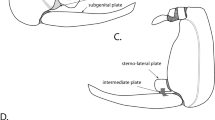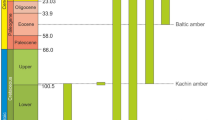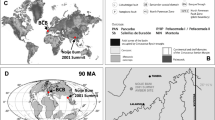Abstract
SNODGRASS1 based his interpretation of the female genitalia of the higher insect orders on the condition in Machilidae. In this family the ovipositor on the eighth and ninth segments is derived from the limb bases. The limb bases of the eighth segment (first genital) may be termed the first gonocoxae (1Gx) with the styli, the first gonostyli (1Gs) and the appendages, the first gonapophyses (1Gpo). Similarly, the ninth segment bears the second gonocoxae (2Gx), second gonostyli (2Gs) and second gonapophyses (2Gpo).
This is a preview of subscription content, access via your institution
Access options
Subscribe to this journal
Receive 51 print issues and online access
$199.00 per year
only $3.90 per issue
Buy this article
- Purchase on Springer Link
- Instant access to full article PDF
Prices may be subject to local taxes which are calculated during checkout
Similar content being viewed by others
References
Snodgrass, R. E., Smithson. Misc. Coll., 89, Pt. 1 (1933).
Snodgrass, R. E., “Principles of Insect Morphology” (New York and London, 1935).
Asahina, S., “A Morphological Study of a Relic Dragonfly Epiophlebia superstes Selys (Odonata, Anisozygoptera)” (Tokyo, 1954).
Walker, E. M., Ann. Ent. Soc. Amer., 36, 681 (1943).
Michener, C. D., Ann. Ent. Soc. Amer., 37, 336 (1944).
Author information
Authors and Affiliations
Rights and permissions
About this article
Cite this article
SCUDDER, G. Reinterpretation of some Basal Structures in the Insect Ovipositor. Nature 180, 340–341 (1957). https://doi.org/10.1038/180340a0
Issue Date:
DOI: https://doi.org/10.1038/180340a0
This article is cited by
-
Comparative morphology of ovipositor in cicadas (Hemiptera: Cicadidae), with considerations on their taxonomic significance
Zoomorphology (2017)
-
Der Ovipositor der Hydradephaga (Coleoptera) und seine phylogenetische Bedeutung unter besonderer Ber�cksichtigung der Dytiscidae
Zoomorphologie (1976)
-
Das Abdomenende weiblicher, terrestrisch lebender Adephaga (Coleoptera) und seine Bedeutung f�r die Phylogenie
Zoomorphologie (1976)
-
Der Ovipositor und die weiblichen geschlechtswege der Thripiden (Thysanoptera, Terebrantia)
Zeitschrift f�r Morphologie der Tiere (1975)
Comments
By submitting a comment you agree to abide by our Terms and Community Guidelines. If you find something abusive or that does not comply with our terms or guidelines please flag it as inappropriate.



